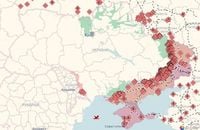The ongoing conflict in Ukraine, which began on February 24, 2022, continues to escalate as Russian forces intensify their military operations. The war, initiated by a directive from Russian President Vladimir Putin, has seen significant developments in recent days, particularly as the Ukrainian military responds to sustained assaults.
According to reports from the General Staff of the Armed Forces of Ukraine, the 1149th day of the full-scale armed aggression against Ukraine was marked by a surge in hostilities. On April 17, 2025, Ukrainian forces recorded 125 combat engagements with the enemy, highlighting the persistent intensity of the conflict. Over the previous day, the aggressors launched two missile strikes and 94 aviation strikes across various regions of Ukraine, employing advanced weaponry that included four missiles and 154 guided aerial bombs. This relentless bombardment also involved 2,764 kamikaze drones and 6,659 artillery shellings targeting both military positions and civilian areas.
Specific locations that bore the brunt of these attacks included several towns in Sumy and Donetsk Oblasts, such as Petrushivka, Osoivka, and Pokrovsk. The situation remains dire as airstrikes have also been reported in the city of Kherson, further exacerbating the humanitarian crisis in the region.
In response to these attacks, Ukrainian defense forces have been actively engaging the enemy, successfully repelling numerous assaults. For instance, in the Kharkiv direction, Russian forces attempted to storm Ukrainian positions near Vovchansk and Zahidne on two occasions. The Kupyansk direction saw five enemy attacks, all of which were thwarted by Ukrainian defenders who maintained their positions near key settlements.
Furthermore, the Lyman direction experienced 16 assaults as the enemy sought to advance near populated areas such as Nadezhda and Novosergiyivka. Ukrainian forces have demonstrated resilience, effectively countering these advances and inflicting significant losses on the Russian military.
The situation on the battlefield is being closely monitored using various online maps that provide real-time updates on the conflict. One such resource, the Deep State map, offers an interactive platform for tracking the progress of military engagements. The map categorizes territories using a color-coded system: blue areas indicate regions liberated from occupiers, green marks territories reclaimed in recent weeks, while red highlights areas currently occupied by Russian forces.
Deep State gathers information from open sources, including social media and eyewitness accounts, ensuring that users have access to the latest developments. However, it is essential to note that while the platform is popular, it is not an official source of information. Users are advised to exercise caution and rely on verified data when interpreting the situation.
As of the latest updates, the Ukrainian military has inflicted considerable damage on Russian forces. Reports indicate that over the past day alone, Ukrainian troops accounted for the loss of 1,230 Russian soldiers, alongside the destruction of 16 tanks, 54 armored vehicles, and 65 artillery systems. This showcases the ongoing effectiveness of Ukrainian defenses in countering the Russian offensive.
In addition to the military dynamics, the humanitarian situation remains critical. Civilians continue to suffer from the consequences of the conflict, and the need for humanitarian aid is more pressing than ever. Authorities have established green corridors to facilitate the safe passage of civilians and the delivery of aid, emphasizing the importance of using these routes rather than relying on potentially dangerous maps for navigation.
Despite the challenges, the Ukrainian military's commitment to defending its sovereignty remains unwavering. The operational information from the General Staff indicates that Ukrainian forces are not only holding their ground but are also actively diminishing the enemy's offensive capabilities. Tactical operations have included successful strikes on enemy command points, air defense systems, and concentrations of military equipment.
The international community continues to monitor the situation closely, with various nations expressing support for Ukraine's efforts to repel the invasion. As the conflict drags on, the implications for regional stability and international relations are profound, with many analysts predicting that the war's outcome will shape the geopolitical landscape for years to come.
In summary, the war in Ukraine remains a focal point of international attention, with ongoing military engagements and significant humanitarian concerns. The resilience of Ukrainian forces, coupled with the strategic use of resources like the Deep State map, illustrates the complexities of modern warfare in the face of aggression. As the situation evolves, the world watches closely, hoping for a resolution to the conflict that has claimed so many lives and disrupted countless others.





